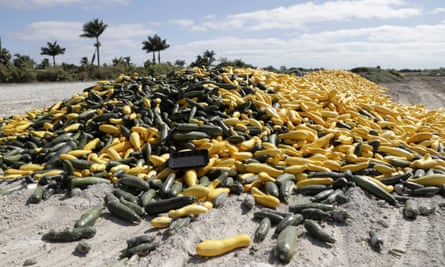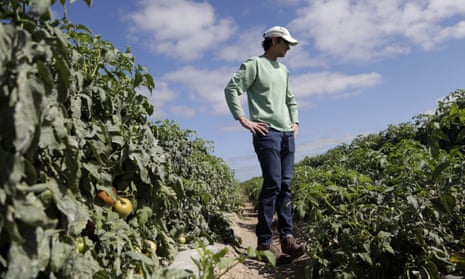Billions of dollars worth of food is going to waste as growers and producers from California to Florida are facing a massive surplus of highly perishable items.
As US food banks handle record demand and grocery stores struggle to keep shelves stocked, farmers are dumping fresh milk and plowing vegetables back into the dirt as the shutdown of the food service industry has scrambled the supply chain. Roughly half the food grown in the US was previously destined for restaurants, schools, stadiums, theme parks and cruise ships.
The impact could be up to $1.32bn from March to May in farm losses alone, according to a National Sustainable Agriculture Coalition report.
Agriculture officials insist that the supply itself is not in question, but matching that supply with demand and getting it to where it’s needed most is a new and urgent problem.

‘A disconnect’ in the food chain
This time last year, half of Paul Allen’s green bean and cabbage crops at RC Hatton farms in Pahokee, Florida, would have been destined for food service. Now he’s plowing 5m to 6m pounds of vegetables back into his fields.
“Retail cannot absorb it,” he said. “Whatever else you’ve got just goes unharvested and you’ve got to mulch it back into the ground.”
Allen is far from alone. He laments the circumstances his tomato-growing friends find themselves in, with 80% or more of their crops previously bound for food service. “Everybody’s in the same situation.”
South Florida is a major producer of vegetables for US consumers, especially in the winter and early spring. Now, for many farmers, the cost to pick and pack that produce is higher than the market price.
“It’s all combined to just be a disastrous situation for south Florida growers, who actually had a bumper crop coming into the harvest season,” said Lisa Lochridge, director of public affairs for the Florida Fruit and Vegetable Association.
“This is really having a disproportionate effect on warm-weather states and smaller farms,” said Kara Heckert, California regional director for the American Farmland Trust. “It was kind of an overnight shift to at least a significant portion of the food system.”

Strawberries on the California coast and lettuce in the Salinas Valley “salad bowl” – which grows roughly 70% of the nation’s lettuce crop – have been hit particularly hard. And efforts to keep farmworkers safe and socially distanced in the fields mean even slower harvesting.
“There’s still a lot being left on the field, and a lot is being tilled underground,” said Heckert. More still is sitting in storage facilities.
Dairy producers in Wisconsin, Vermont and other states have taken to dumping excess milk en masse, flooding their fields or pouring it down drains in production facilities. The loss of food service business, particularly schools systems that are large buyers of dairy products, has left producers with a highly perishable glut that they can’t easily resolve.
Preparing and packaging food for retail as opposed to wholesale, and getting it packed and shipped on trucks, is an entirely new and expensive problem. And spring is an especially productive season for dairy cows, leading to even more supply in a time with even less demand. Over the last six weeks, US dairy futures prices have nosedived.
Still, said Heckert, there’s confusion over where the pipeline is facing the most stress. “A lot of the grocery stores are limiting how much milk people can buy, thinking it’s going to run out. There’s a disconnect there.”

Farmers filling the gaps
For farmers with direct-to-consumer produce box services, the chaos has been a boon. In the northern San Francisco Bay area, every farm delivery program is full, some with waiting lists in the hundreds.
“We’re using this as an opportunity to encourage collaboration and farmers working together to try to fill the gaps in this disruption,” said Evan Wiig, membership director at the Community Alliance with Family Farmers, which is working to pair farms that previously sold direct to schools and restaurants with already established delivery logistics.
“It’s been kind of a mad rush to figure out supply and demand and who needs what, who has what,” he said. “This is usually something that you do carefully over the course of an entire year. And here we are trying to do it in a matter of a week in order to prevent the closure of the farms, and also a lot of food waste.”
Before the coronavirus, nearly all of Brothers Produce business was food service and school delivery. In March, Brent Erenwert, CEO of the Houston, Texas, food distributor, created an entirely new model to keep his employees in business and his company afloat: selling produce boxes with fruits, vegetables, eggs and milk through co-ops in the region, and direct to customers online.
“Some consumers don’t feel safe going to the grocery store, unfortunately, because of too many people being there. I know how to get that product safely to a consumer’s hand,” said Erenwert. “The biggest thing was to keep my employees’ jobs and keep the supply chain moving – because if people see the supply chain stop, they go into even more of a panic.”

But that supply chain is missing a crucial link, bridging the gap between food that would be wasted and a growing need in food banks nationwide.
Many growers already reeling from huge losses in sales aren’t able to further eat the cost of harvesting, packing and transporting crops to needy food banks without any financial aid. Florida growers have asked the US Department of Agriculture to buy the surplus produce so it could be donated to people in need without further hurting farm finances. The California department of food and agriculture is partnering with the California Association of Food Banks to provide funding and resources for farm donations to feeding programs across the state.
Still, there’s only so much that food banks can take.
“What’s really weird right now in the supply chain is the grocery stores seem to be pretty heavy on product, farmers are throwing away stuff, and food banks are full. We don’t know where the demand lies,” said Erenwert.
“We’re working with the state to try to get it to charities. But quite frankly, a lot of those avenues are full,” said Paul Allen, a Florida vegetable grower. “They can’t absorb it all, no way.”
Food banks aren’t set up to be warehouses for such vast quantities of stranded and highly perishable food.

“Everything under the sun produce-wise is showing up. We’re getting the cream of the crop,” said Brian Greene, CEO of Houston Food Bank. “We have a potential bonanza – now we’re working on the ability to capitalize on it. All the food banks have to solve this puzzle. What are the partnerships we set up so we can utilize this? Because we’re not going to get the other things.”
With shelf-stable staple goods selling out at markets nationwide, food banks are finding it difficult to secure surplus dry and frozen goods. This influx of produce could help shore up a dip in donations, but it requires more workers and volunteers to sort and package the food when charities are in short supply of helping hands. There’s no doubt, said Greene, that much of this food will unfortunately still go to waste.
“The reality is what makes the food chain work normally is there are just tens of thousands of arrangements that have been developed over time in order to match supply and demand. Then you just suddenly break all that and you’re trying to, with voluntary relationships, piece something together in a very short timeframe,” he said. “There’s going to be a lot of failure.”
